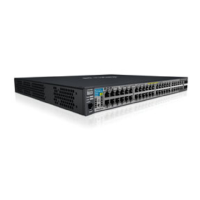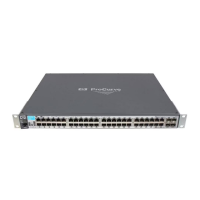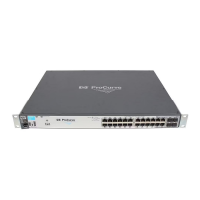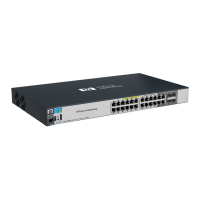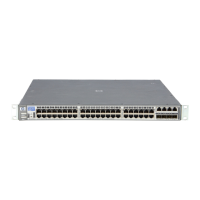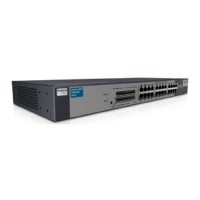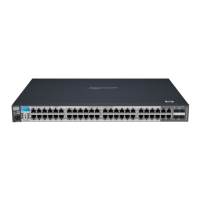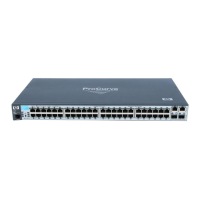
Do you have a question about the HP PROCURVE 2910AL and is the answer not in the manual?
| Model | HP ProCurve 2910al |
|---|---|
| Switching Capacity | 128 Gbps |
| Throughput | 95.2 Mpps |
| Management | Web, CLI, SNMP |
| Jumbo Frame Support | Yes |
| Manageable | Yes |
| Power | 100-240 VAC |
| Power Supply | Internal |
| Operating Temperature | 0°C to 45°C (32°F to 113°F) |
| Stacking | Yes |
| MAC Address Table Size | 32000 entries |
| Routing Protocol | RIP, OSPF |
| Features | IPv6, VLAN, QoS, ACLs |
| Operating Humidity | 15% to 95% non-condensing |
| Uplink Ports | 4 |
| Power over Ethernet | Yes (PoE+ models available) |
Provides an overview of the security features included on your switch.
Overview of the switch’s access security features, authentication protocols, and methods.
Outlines features and defense mechanisms for protecting access through the switch to the network.
Enforces a security policy to ensure ease of access is not used by unauthorized persons.
Provides guidelines for controlling SNMP access to the switch and preventing unauthorized access.
Explains how port-based security options and client-based attributes are prioritized on the switch.
A plug-in to ProCurve Manager Plus that uses RADIUS-based technologies for user-centric network access management.
Details features and access levels for username and password security.
Provides methods for setting, deleting, and recovering passwords via Menu, CLI, and Web interfaces.
Explains how to store and display security settings in the running-config file.
Covers features to prevent malicious users from resetting passwords or gaining physical access.
Introduces Web and MAC authentication for port-based security on network edges.
Explains the process of Web and MAC authentication via RADIUS server.
Details rules for concurrent authentication, port access management, and VLAN interactions.
Outlines the steps for configuring Web and MAC authentication, including server setup.
Provides commands and procedures for configuring Web authentication.
Provides commands and procedures for configuring MAC authentication.
Describes possible client status information reported by the 'show... clients' command.
Explains TACACS+ authentication for centralizing access control and privilege levels.
Lists the necessary components for using TACACS+ authentication.
Details the process for setting up and testing TACACS+ service to prevent lockouts.
Outlines steps and commands for configuring TACACS+ operation on the switch.
Describes the general authentication process using a TACACS+ server.
Provides methods to prevent unauthorized access through the web browser interface.
Lists and explains CLI messages generated during TACACS+ operation.
Provides important notes and considerations for TACACS+ operation.
Introduces RADIUS for user identity verification and network resource usage tracking.
Explains how RADIUS can assign CoS and rate-limiting attributes.
Details the rules and requirements for using RADIUS authentication.
Provides preparation steps and information for configuring RADIUS on the switch.
Outlines the steps and commands for configuring RADIUS authentication.
Describes how to use SNMP for accessing and managing switch authentication settings.
Explains how the switch reverts to local authentication when RADIUS is unavailable.
Provides methods to prevent unauthorized web browser access.
Details how RADIUS authorization controls access to CLI commands.
Explains how to configure RADIUS accounting for user activity and system events.
Provides commands to view general, authentication, and accounting statistics.
Describes how to modify the order in which the switch accesses RADIUS servers.
Lists and explains messages related to RADIUS operation and potential issues.
Provides information on setting up a RADIUS server for switch features like CoS, Rate-Limiting, and ACLs.
Guidelines for dynamically applying CoS and Rate-Limiting to authenticated clients.
Displays the CoS and Rate-Limiting settings imposed by the RADIUS server on active client sessions.
Describes how to apply RADIUS-assigned ACLs on the switch for IP traffic filtering.
Highlights key differences between static ACLs and dynamic RADIUS-assigned ACLs.
Explains how ACLs are identified and invoked by client credentials.
Suggests a process for using RADIUS-assigned ACLs to establish access policies.
Provides guidelines for configuring RADIUS servers for RADIUS-assigned ACLs.
Details the syntax and operating information for ACLs configured in a RADIUS server.
Illustrates configuring RADIUS-assigned ACL support for client identification methods.
Explains the structure of a RADIUS-assigned ACL for filtering authenticated client traffic.
Provides notes on explicitly permitting/denying IP traffic and ACL structure.
Introduces SSHv2 for secure remote access and authenticated transactions.
Details requirements for using the switch as an SSH server, including client applications.
Outlines general steps for configuring SSH for two-way authentication.
Provides details on client public-key authentication and storage of public keys.
Lists and explains messages related to SSH operation and potential issues.
Introduces SSL/TLS for secure remote web access via encrypted paths.
Details requirements for using the switch as an SSL server, including browser applications.
Outlines general steps for configuring SSL for switch and client authentication.
Lists common errors encountered during SSL setup and their possible causes.
Defines ACLs and describes how to configure, apply, and edit IPv4 ACLs.
Explains static and dynamic ACL applications and their types.
Describes the operation of static ACLs, including packet filtering and sequential comparison.
Guides on defining policies, identifying traffic, designing ACLs, and positioning them.
Details commands for creating, editing, and managing standard ACLs.
Details commands for creating, editing, and managing extended ACLs.
Provides steps for creating and configuring named extended ACLs.
Explains how to assign or remove ACLs from switch interfaces.
Covers editing ACLs using sequence numbers via CLI or offline methods.
Lists commands to display ACL summaries, configurations, and assignments.
Describes how to monitor ACL performance using statistics counters.
Provides an alternative method for creating or editing large ACLs using offline files.
Explains how to enable ACL logging to generate messages for explicit 'deny' actions.
Covers notes on ACL limitations, IP traffic screening, and logging.
Introduces advanced threat protection features for network defense.
Protects the network from common DHCP attacks like address spoofing and exhaustion.
Protects the network from ARP cache poisoning attacks.
Detects anomalies caused by security attacks or irregular operations using operating parameters.
Describes applicable switch models and features for traffic/security filters.
Explains how static filters work and their limitations.
Enables forwarding or dropping traffic from indicated source ports to specific destination ports.
Allows specification of named filters for multiple ports and trunks.
Enables forwarding or dropping multicast traffic to specific destination ports.
Enables forwarding or dropping traffic based on protocol type.
Provides procedures to specify filter types and actions on the switch.
Specifies inbound ports and defines actions for destination ports/trunks.
Allows changing the action for destination ports/trunks in an existing source-port filter.
Configures filters for multicast addresses or protocol types.
Explains how filters are assigned index numbers and how they are managed.
Lists all filters by index number and displays individual filter details.
Introduces 802.1X access control for network security and user profile management.
Highlights key 802.1X features including authenticator/supplicant operation and user-based control.
Outlines prerequisite steps and general procedures for configuring 802.1X access control.
Details the steps for configuring 802.1X authentication on switch ports.
Provides commands and procedures for configuring switch ports as 802.1X authenticators.
Describes Open VLAN mode for clients needing to acquire 802.1X supplicant software.
Provides commands to display 802.1X configuration, statistics, and counters.
Explains how RADIUS/802.1X authentication impacts VLAN assignments.
Introduces port security features including basic operation and MAC lockdown.
Covers configuring port security, authorized addresses, and intrusion detection.
Explains MAC Lockdown for permanent MAC address assignment and preventing hijacking.
Enables blocking specific MAC addresses from sending or receiving traffic.
Describes how to check for intrusions and configure port security via the web interface.
Explains how to view, acknowledge, and reset port intrusion alerts.
Introduces the Authorized IP Managers feature for controlling network access via IP addresses.
Covers authorizing single stations or groups of stations for management access.
Explains how IP masks are used to recognize authorized manager station IP addresses.
Details how to view and configure IP authorized managers using the menu interface.
Provides CLI commands for viewing and configuring authorized IP managers.
Describes how to configure IP authorized managers using the web browser interface.
Explains how IP masks define authorized manager station IP addresses.
Provides security precautions and notes on IP managers and web proxy servers.
Introduces the Key Management System (KMS) for configuring security mechanisms.
Details steps for creating and assigning keys to key chains.
Explains how to assign a key with no time constraints for a key chain entry.
Explains how to assign keys with activate and deactivate times for a key chain entry.
